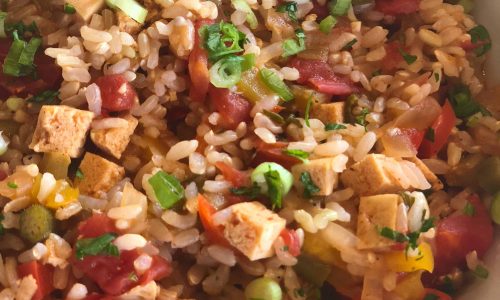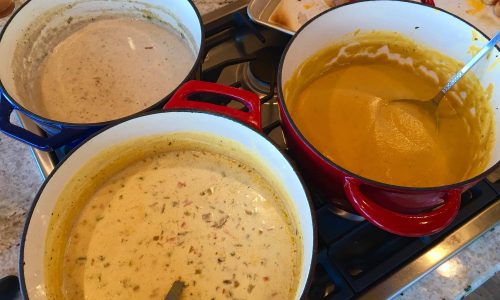I really enjoyed this class. Chef Loy lectured briefly about fillings, going over the differences between high and low pectic fruits, encouraging us to use a minimum amount of sugar so the fruit can be tasted. Fruit fillings need to have some starch so the rule is to use 1 1/2 tsp of starch per cup of fruit. Nutmeg goes with berries, cinnamon for apples, and cloves for peaches and apricots. Ginger goes with anything (but don’t use too much). One thing he mentioned that I never really thought about was mixing 2 fruits to keep from being boring/ordinary. Mix 1 apple into a peach pie, or use 3 types of berries instead of 1.
My cooking partner Kristin and I had the following assignments:
Kristin:
tart glaze
caramel sauce
lime chiffon
baked fruit filling
I had:
dark chocolate syrup
frangipane
fruit coulis
blueberry pie filling (cooked juice filling)
champagne sabayon
For once all my dishes turned out well! Probably because this was an easy class, but what the heck, after last week it was nice to have success. It probably didn’t hurt that I was really trying hard to improve my performance from last week. I read the instructions first this time and focused on producing a quality dish every time. I think the frangipane is really delightful. Nutty, fluffy, sweet and it will be great in a tart or bear claw. I used blueberries, raspberries and strawberries for the pie filling and it was tasty–a little lime juice and zest brightened it up.
I was very pleased with the peach ginger lime coulis. I pureed frozen peaches (thawed first) with crystallized ginger, strained them and added sugar and lemon juice. This was very fresh and wonderful. I like the fresh coulis better than the type where the fruit is cooked, then strained.
Fruit Coulis
16 oz fruit puree, strained
2 1/2 ounces sugar
1 ounce corn syrup
1/2 ounce lemon juice
Make fruit puree by taking 1 lb of fresh or frozen fruit, 2 T sugar and 2 T fresh lemon juice and processing in blender or food processor until smooth. Pour into a fine sieve set over a bowl and use a rubber spatula to press the puree through the sieve; discard solids.
My sabayon turned out very nicely and although I don’t think I’ll be making it for myself (it takes 8 egg yolks!) at least I know what it looks like and next time the Chopped or Top Chef contestants talk about their sabayon I won’t be wondering how it’s made.
My chocolate syrup was great–and I will find a way to use it when we make finished products.
The past few weeks we have been making components that we will be able to put together over 3 classes. We’ve made pie crusts, croissant dough, puff pastry, custards, etc. and put them in the freezer. Theoretically we should be able to pull out these components a couple weeks from now and make finished products. Trouble is who can remember what we made? My mind is clogged up with planning a national social work conference to be held in 3 weeks and I haven’t even written my speeches yet! So when I can’t sleep at night I’m alternately trying to remember what’s in the freezer at culinary school and what the Bureau of Prisons social workers should hear about at the conference. The other problem is with my so call components. I know I can’t use my puff pastry because it was not good. We froze the “lock-in” one week and rolled it out the next week and this was not successful. We are allowed to make another batch of puff pastry at home and bring it in but that is the only thing we can bring in. Some of my other components were not very good and I didn’t save them. I threw out my pastry cream and creme anglaise so I’ll have to re-make them as well. We will have to make 1 pie, 1 cake, 2 laminated items, a stirred custard, and a baked custard over the 3 classes. That really doesn’t sound too bad, but then nothing does until you’re standing in the kitchen at school and time is flying by!
I have been practicing though. I have made pie crust at home at least 4 times and my family is sick of coconut cream pie. I made blitz pastry puff twice now and palmiers are also on the “don’t make that again” list. My pastry cream is light, smooth and delicious and everyone loves it.
For the 4th of July I am making a tart pastry filled with berries and mascarpone cheese with a blueberry coulis. I hope by the time we have the final exam I’ll be able to make the required items with ease. As strange as it sounds I’m really enjoying the pastry class and find myself studying the notes from class and thinking about making things all the time. I have purchased several books and read them at night when I’m bleary eyed and tired. When my husband is watching TV I’m reading:
Bakewise by Shirley O’Corriher
Cookwise by Shirley O’Corriher
The Essentials of Baking, Williams and Sonoma
Baking Boot Camp
Chocolates and Confections (CIA) by Peter Greweling
Ratio by Michael Ruhlman
I have made lists of new recipes to try, tried new techniques for making puff pastry and pie crust and my counter is cluttered with stacks of my notes, recipes, books, equipment.
If someone were to come into my house and look at the books in my kitchen and then the ones in my bedroom they might be surprised to find that I’m also reading:
The End of Overeating by David Kessler
Move a Little, Lose a Lot by James Levine
Although I’m in pastry class now I am also interested in living a long time so another side of me is very aware of downside of gourmet eating and cooking!
At the 2009 Southwest Foodservice Expo earlier this week I was reminded of my interest in nutrition and health when I attended a demo by an instructor from Remington College. He spoke of 21st century nutrition and how important it is to be nutrition-saavy today. After all, the baby boomers like me are now in our late 40’s through 60’s and we are now focused on living a quality life well into our 90’s. We are not passive and content with listening to mainstream authorities when there is a better way. The chef demonstrated using ancient grains to make things such as a quinoa tortilla, a crepe with amaranth, and a wild rice and black rice waffle. For moisture he used what he called “tri solution”, a mixture of silken tofu, soy milk, yogurt, and rice milk. He spoke of reducing salt, fat, and chemicals in our food–all of great interest to me.
I tasted the things he made and found them to be very unusual and good. Compared to the very highly seasoned, fatty, sugary, and salty things I had been sampling earlier his things were rather bland but I know that if I’m not eating the aforementioned common foods the natural dishes taste much better.
The culinary trend of today seems to be more of a focus on healthy, sustainable, organic, and local. At the Texas Chef’s Association meeting this week Chef Michael Moribito started the round table by asking all the attendees to consider growing their own gardens. All present spoke of their home gardens if they had one. I laughed to myself because I am now on my 3rd year of growing vegetables seriously. For many, many years my mother always had a huge yard of vegetables and fruits which she always wanted to show me. I yawned through most of her tours and photos of her perfect vegetables and fruits. She was particularly proud of her persimmon tree and fig tree. When she moved in with me in 2000 she wanted a small vegetable garden so we made her one every year which she faithfully watered, weeded, and cared for from the ages of 76 to 81. I enjoyed the vegetables she grew but was way to “busy” to get very involved. We moved in late 2005 to our current house and created a space outside her bedroom door for a small vegetable garden, but she died in the spring of 2006 before we could plant it. While she was in the hospital in late March she told me to be sure to buy the Japanese eggplants at Russell Feed Store in Benbrook, the only place she could ever find Ichiban eggplants. So I trekked over there and bought several plants. She never saw the end result but she would have been pleased.
The next year I had a man come out and create a raised bed that is 20 feet by 12 feet. I have since had both an herb garden outside her bedroom door (which is near my kitchen) and I always plant shiso (perilla) for her and a garden full of Japanese eggplant, Japanese cucumber, tomatoes, edamame, various peppers, green beans. I have a raspberry bush and strawberry plants. When I’m out in the garden I think about my mother and know she would have been so thrilled to see all the perfect vegetables and know how much I enjoy cooking them, eating them, and sharing them with others. I wish I had taken the time to learn all her gardening tips when she was alive but I was so “busy” then. The least I can do is have a garden in honor of her memory and perhaps pass on her love of gardening to my four children and grandchildren. One of my children, my son Glenn, loves the garden and the biggest enthusiast is my granddaughter Kyndal. At 5 she comes over every week and the first thing she wants to do is pick berries or tomatoes and always insists to have a lot to take home with her. She also wants to be a chef!


